Developmental
Lecture 1 - Intro, Methods, Lifespan Development
intraindividual changes: changes within a person
interindividual differences: differences between people
systematic changes: orderly patterned and relatively enduring
not every development is gain-stability-loss like biological development → there is both gains and losses at every developmental stage even in old age
What develops?
biological
cognitive
social and emotional (psychosocial)
→ MULTIDIMENSIONAL!!!
When do they develop?
normative development → developmental stages at certain ages

❕Biological age is not the cause of change!!!
→ biological age and change is only correlated
Variability: short-term
Change: long-term
age x ability correlation: continuous
mean age difference in ability: compare specific age groups
cross-sectional: different age groups at once → measure interindividual differences
longitudinal: same group different times → measure intraindividual change
cross-sectional
problem: cohort effects (cohort are exposed to different historical events)
+ economic in time
+ cheap
+ differences between age groups
- no info on individual paths
- limited generalizability to other times
longitudinal
problem: time of measurement effects (there was an historical event at the time of measurement)
+ intraindividual stability and change
- test-retest, attrition
- long, expensive
- limited generalizability to other cohorts
sequence models (cross-sectional + longitudinal)
How do they develop?
Baltes’s principles of lifespan psychology:
lifelong
multidisciplinary and multidimensional
multidirectional (different capacities show different patterns of change over time → different rates and times)
gains and losses (joint occurrence, balance)
plastic (dandelions…)
embedded in history
contextualized (photo below)
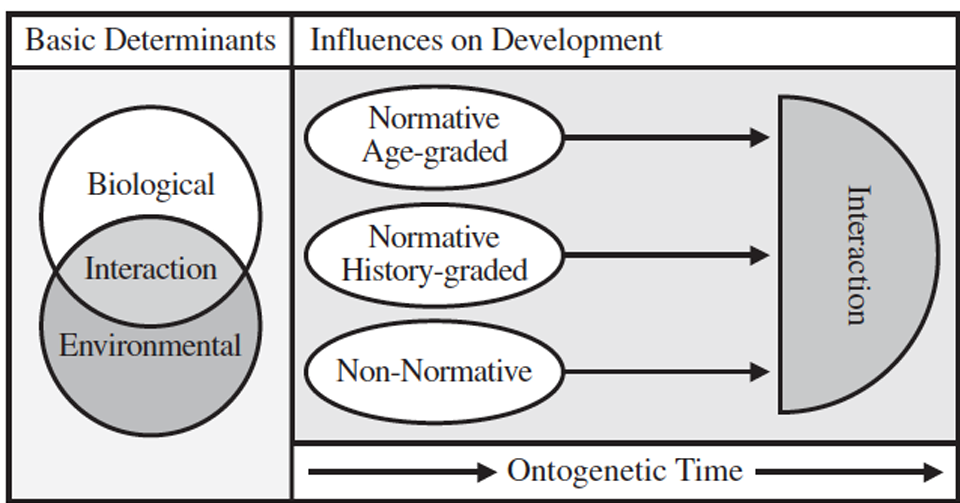
normative age-graded: certain age (menapouse)
normative history-graded: certain point in time (effects the whole population like covid)
non-normative: unpredictable
Cultural differences
age grade: different roles, status, like year grades in school
rite of passage: marking transitions between age groups, traditional
age norms: how to act your age → SOCIAL CLOCK
Historical changes
children were once viewed as little adults
adolescence were once had to work (before child labor laws)
new age group “emerging adults” because longer education
middle age emerged because of empty nest phenomenon
old age as retirement → people used to work until they died
gerontology: study of aging and old age
Lecture 2 - Theories

Nature-nurture interactions
gene-environment interactions
People with different genes are affected differently by environmental influences → different genes react differently to experiences NATURE AND NURTURE
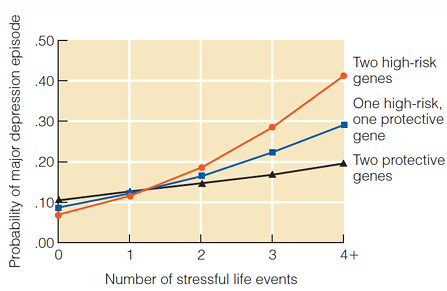
diathesis-stress model: psychological disorder results from an interaction of a person’s vulnerability and stressful events
differential susceptibility theory: some people are more reactive to environment, either good or bad (dandelions or orchids)
gene-environment correlations (passive/active/evocative)
people with different genes have different experiences (shy or extroverted people) NATURE AFFECTS NURTURE
passive → sociable parents both pass their genes and invite more people to their home
evocative → social children get more hugs and smiles and more opportunities to socialize which reinforces sociability (gender video)
active → shy kids prefer reading books
genetic make up is related to:
parent
tv time
number of stressful events
NO CAUSATION - UNCLEAR
epigenetics
gene expressions can change because of environmental influences (environment-sensitive genes) → turn on or off NURTURE AFFECTS NATURE
Continuity-discontinuity
continuous: quantitatively better
discontinuity: qualitatively different stages
Psychoanalytic theories (Freud/Erikson)
personality, motives, emotional conflict
Freud
conflict between:
id: impulsive, selfish, need to satisfy instincts
ego: rational, tries to find realistic ways to satisfy instincts
superego: morality
psychosexual stages:
oral 0-1: oral gratification from mother (trust/mistrust)
anal 1-3: biological needs vs societal demands (autonomy/shame and doubt)
phallic 3-6: genitals, Oedipus and Electra complex, superego (initiative/guilt)
latent 6-12: libido is quiet (industry/inferiority)
genital 12+: puberty (identity/role confusion)
Erikson’s psychosocial theory (nature-nurture active, discontinuous, universal)

Learning Theories

both conditioning: nurture, passive, continuous, context
observational learning: nurture, active, continuous, context
Systematic Theories: Bronfenbrenner ecological model
microsystem: people and institutions that play an immediate role in a child’s life
mesosystem: interactions between groups in the microsystem
exosystem: individual is not an active member, government policies, social services, community resources, mass media
macrosystem: micro+meso+exo political social cultural legal economic systems/attitudes
nature-nurture, active, continuous-discontinuous, context
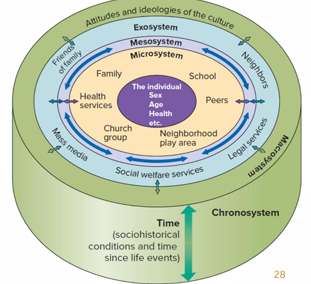
Theories on Childhood
Piaget’s cognitive development (nature-nurture, active, discontinuous, universal)
0-2 sensorimotor: object permanence
2-7 preoperational: mental/symbolic representations, language, egocentrism
7-12 concrete operational: logical reasoning, reading/writing, math, categorizing, conservation of number and mass
12+ formal operational: scientific reasoning and hypothesis testing
Sociocultural theory of Vygotsky ( nurture, active, continuous, context)
shared process with “more knowledgeable other”
zone of proximal development: gap between child’s ability to solve a problem on its own and potential development with help
scaffolding: degree of support adapted to child’s level of ability and is reduced gradually
!!!Language by parents stimulates cognitive development (children learn via inner speech)
Middle age theory: social clock model
nurture, passive, discontinuous, context
adults are affected less by biology and more free to make decisions on their development
Old age theories
selective optimization with compensation (SOC)
selection: focus on limited skills and goals
optimization: practice, focus on your best
compensation: develop ways around
nurture, active, continuous, context
Socioemotional selectivity theory
nature, active, continuous, universal
old people prioritize emotionally meaningful goals than exploration
positivity effect: old people actively chose to remember positive memories
Summary
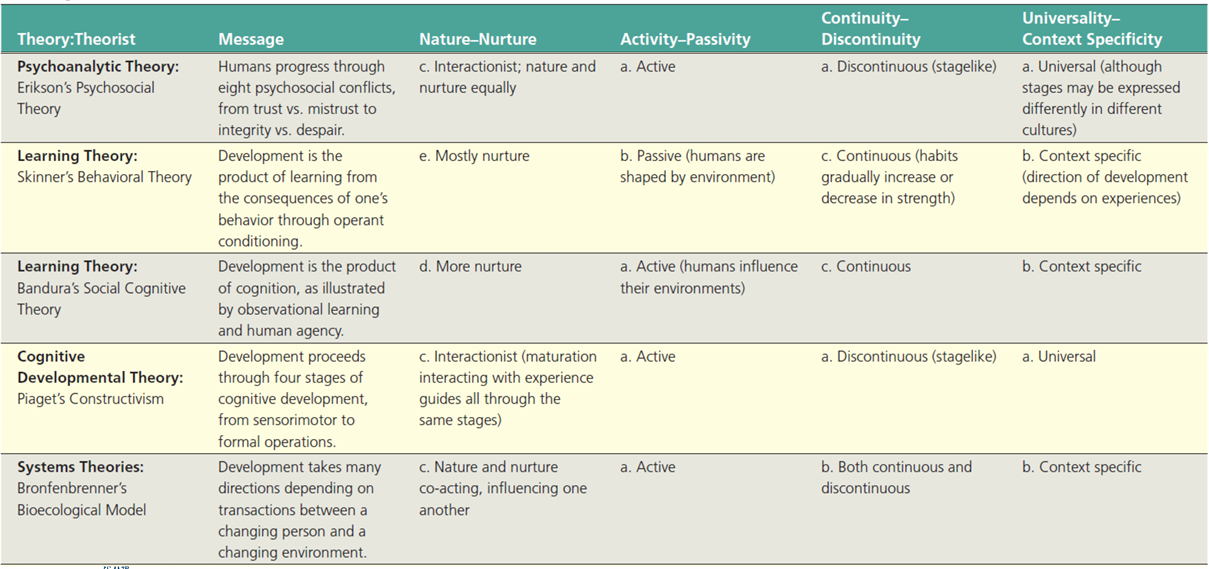
Lecture 3 - Prenatal Brain & Sensory Development
What are the different phases of prenatal development?
1. Germinal phase (week 0-2) 1st trimester
2. Embryonic phase (week 3-8) 1st trimester
3. Fetal phase (week 9-38) all trimesters
germinal phase
Primary objective: Development of zygote (cell created during fertilization) into blastocyte (layered cell mass with a cavity) and nesting in uterine wall
very sensitive, 50% miscarriage
at the end of the phase: 250 cells
embryonic phase
primary goal: organogenesis including the heart
three principles of growth:
Cephalocaudal principle (from top to bottom): first head then bottom → babies heads are bigger relatively to their body
Proximodistal principle (from in- to outside): first center then extremities → arms and legs remain short and chubby
Orthogenetic principle (from mass to specific/undifferentiated to differentiated): first simple then refinements → fingers
POSSIBLE EXAM QUESTION → WHICH DEVELOPS FIRST
week 3-4:
blastocyte into three layers:
endoderm: digestive and respiratory system
mesoderm: muscles, skeletal, heart circulation
ectoderm: skin and the nervous system
neural tube (brain-spine)
week 5-8:
organ development according to three principles
by week 8 most organs are fully developed
fetal phase
primary objective: growth of embryo and refinement of structures
CRITICALPERIOD FOR BRAIN DEVELOPMENT!!!
brain: doubles in size from month 4 to 7, neural tube → 100 billion neurons, brain folding
proliferation: intense cell growth
migration
differentiation
at week 20 baby is almost fully developed
age of viability: 22-23 weeks
50/50 odds of survival by week 25
normal: 38 weeks
Teratogens
infectious diseases, medications, drugs, environmental toxins, nutritional deficiencies, maternal stress
most harmful during embryonic phase, bc organs develop
2nd and 3rd trimester negative effect on brain
dose dependent: 1 cup of coffee is fine
individual differences → vulnerability difficult
EXAMPLES:
medication: softenon, to prevent morning sickness in 1st trimester → missing or underdeveloped body limbs
smoking: reduced blood flow, less nutrients and oxygen, strongest effect in last trimester (brain development) → miscarriage, early or small, asthma, cognitive problems, behavior regulation, adhd, antisocial
third variable problem: stress can both mothers consume alcohol and impact development
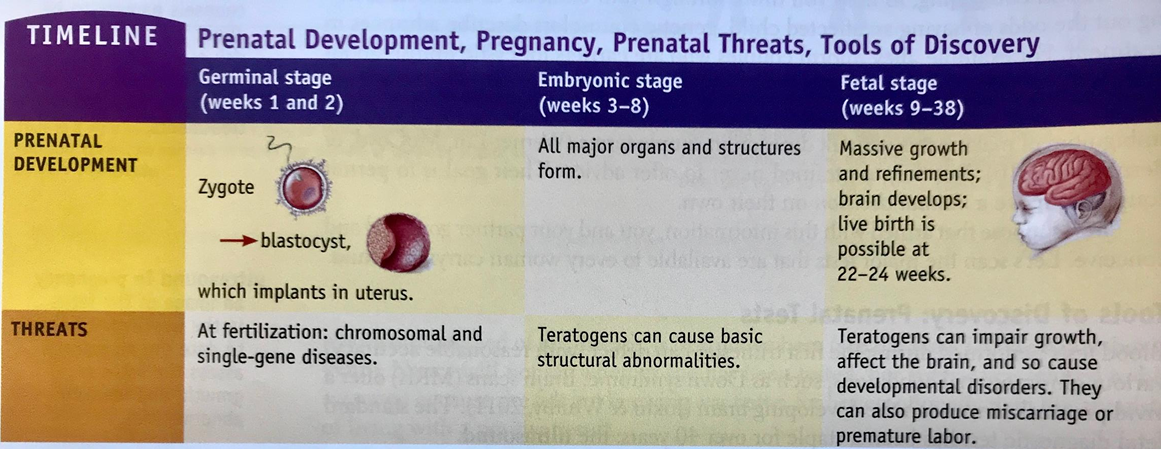
Brain development
“neurons that wire together fire together” → repetition is important for learning
post-natal brain processes
synaptogenesis vs synaptic pruning
myelination vs apoptosis
Baltes: plasticity, gains and losses, maybe contextualized
myelination
baby(until year 1) → visual cortex
toddlers → language areas
adolescence → prefrontal cortex
until adulthood → continued mylenation
brain development across the life span
brain lateralization: asymmetry and specialization of functions of the two brain hemispheres
PREFRONTAL CORTEX:
most prolonged development → age 1, peak synaptic density; age 15, adult level synaptic density
myelination continues until early adulthood
Study: comparison of brain volume trajectories (N=2944 ages, 9 months- 94 years)
grey matter: lifelong decrease
white matter: peaks in middle age, inverted u-shape
Baltes: lifelong, maybe gains and losses and plasticity
plasticity
due to:
→ development
→ learning and memory
→ cerebral changes (lesions, neurodegeneration, aging)
greatest during early development
active old adults have less shrinkage (atrophy) in prefrontal cortex and hippocampus (greater gray matter in PFC)
⬇
what is this an example of? gene-environment interaction → environmental influences (exercise) interact with genetic predisposition (atrophy)
Sensory development
smell & taste
INFANTS:
smell:
smell of breast milk - soothing
recognize the smell of the mother and the breast milk
taste:
prefer sweet
OLDER ADULTS:
smell:
small decrease, starts in adulthood (but only for pleasant odors)
ability to detect unpleasant odors does not change
taste:
greater decrease in men, but large differences
reason of decrease: less saliva
CONSEQUENCES:
decrease in quality of life and physical well-being (higher mortality
less pleasure in eating or eating spoiled food
BUT taste and smell receivers are renewed throughout life
touch & pain
INFANTS:
touch:
important for bonding (increases successful breastfeeding)
affects brain development (synaptogenesis, hormones) → calmer so sleep better?
pain:
19-20 century: pain is just reflex
1990: even fetuses can feel pain
CONSEQUENCES:
touch:
reduced sensitivity (reduced tactile receptors, demyelination)
pleasant touch becomes more important and even nicer (bc less frequent)
pain:
less sensitive to weak pain (but no difference for high levels of pain)
hearing
important for communication, more developed than vision:
newborn (and pregnancy): recognize mother’s voice → greater exposure
1 month: speech directed at baby → starts learning
7 month: no difference in response to native or other languages
11-12 months: greater response to native language, less sensitive to sounds in other languages
Baltes: plasticity
CONSEQUENCES:
presbyacusis: age-related hearing loss → decrease in hair cells
decrease in ganglion cells, higher threshold for pure tones
tinnitus: ringing in the ears
hypersensitivity for loud sounds
vision
matures later than other senses:
newborns: cannot see sharply yet
3 month: color vision not yet measure
1 year: same as adult
form perception: motion information → 3 months
newborns can discriminate faces and non-faces!!!
from 2/3 months meaningful perception of a face:
2 months: prefer speaking faces
8 months: hypersensitivity to fear expressions → fear bias
9 month: less sensitive to facial expressions in other ethnic groups
DEPTH PERCEPTION:
1 month: blinking for looming objects
4 month: objects are the same size no matter the difference - size consistency
6-7 month: fear of heights (depth perception already exists at 2-4 months but not crawling yet)
social referencing: checking parent’s emotions when confronted with a new situation
OLDER ADULTS:
increased intraocular pressure (less light, reduces sharpness)
presbyopia: aging of the eye
decline in dynamic vision (movement)
contrast sensitivity (stairs)
Lecture 4 - Cognitive Development 1 Piaget
assimilation: existing schema is used in new situations (magazines as ipads)
accommodation: when the existing schema does not work, adjustments need to be made
equilibration: balance between assimilation and accommodation
Sensori-motor (0-2)
circular response: develop through repetitive behavior patterns
birth - 1 month | reflexes | newborn reflexes |
1-4 month | primary circular responses | simple motor habits focused on own body |
4-8 month | secondary circular responses | repeating movement to see interesting effects on the environment |
8-12 month | coordinating secondary circular responses | intentional, goal-oriented, object permanence |
12-18 month | tertiary circular responses | “little scientist” exploring with new actions |
18 month - 2 year | mental representations | delayed imitation: internal representation of objects or others |
object permanence
around 9 months, tested by A-not-B error
Piaget → immature object permanence
BUT memory inhibition, planning and positive reinforcement (baby talk) could play a role
criticism
underestimated abilities
basics of physical reality before age 1
gradual development rather than qualitative stages
→ now computer-like info processing
RESEARCH:
continuity of movement (<1 year): looking longer after the toy does not fall off the table
CONCLUSION:
earlier than Piaget thought:
basic laws of nature
emotion and intention of others
imitation
Pre operational (2-7)
symbols & language
PRODUCT of cognitive development (Vygotsky → CAUSE of cognitive development)
words to refer to things not present
past and future
pretend play
intuitive reasoning “magical thinking”
primitive reasoning → own logic
they know everything
“why?”
CAUSAL UNDERSTANDING:
feelings of participation: participates in nature (magical beliefs) → “ı make the moon move when I walk”
animism: things are conscious and alive → “clouds move bc they feel cold”
artificialism: everything is willed, intentionally organized for men → “sun shines to warm people”
finalism: everything has an explanation → “little boats float bc they are not haevy and big boats float bc they are heavy”
CONSEQUENCES:
afraid of monsters and the dark → animism
imaginary friend
lack of conservation
why:
centering: attention to most salient parts → single aspect
irreversibility: not able to mentally reverse change
static thought: fixed on end states rather than the transformation
Example: not understanding identity constancy → people remain themselves despite changes in appearance
egocentric perspective
leads to meaningless conversations between children
tested by three mountains test:
→ given 10 different points of view “what does the doll see?”
— complex
— not adaptive to children’s life
alternative: hide the doll from the police men
own perspective: age
other perspectives: age 7
Concrete operational (7-11)
→ realistic understanding of the world
→ logic reasoning (only concrete, not yet abstract)
→ inductive reasoning (which enhances memory and strategy)
conservation ✅
classification ✅

preoperational: dogs
concrete operational: animals
class inclusion: logical understanding that parts are included in the whole
seriation ✅
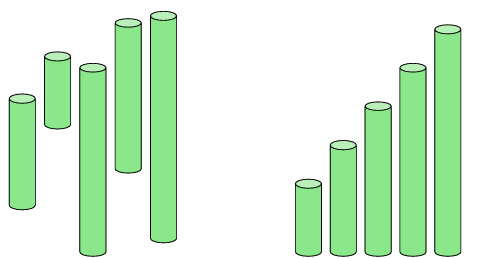
transitivity ✅
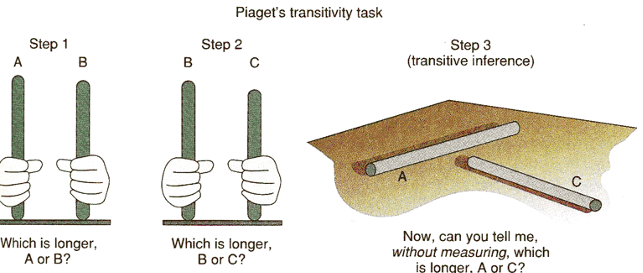
pre to concrete
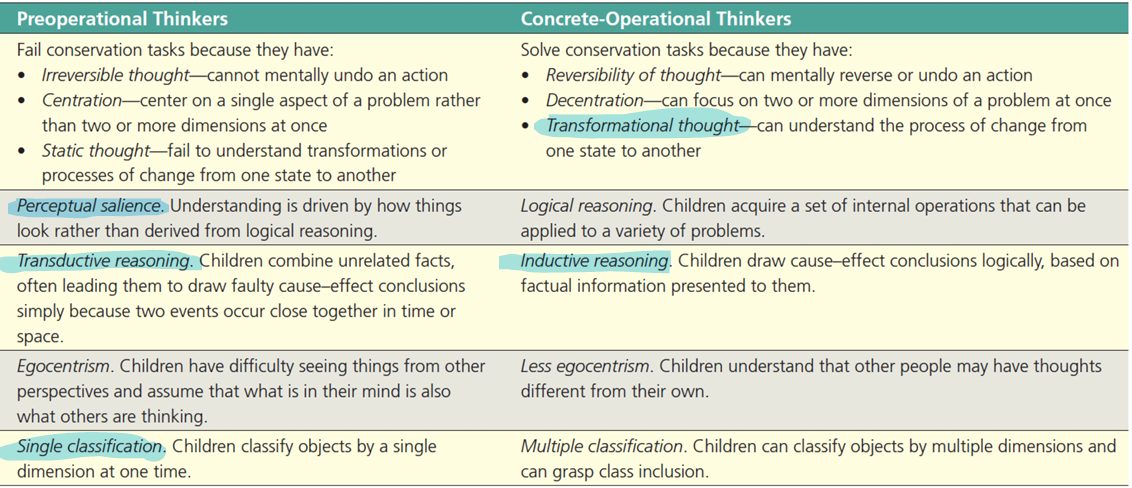
Formal operational (12+)
abstract thinking
logical thinking
adolescents as scientists → hypothetical-deductive reasoning
→ hypothetical deliberations (“assuming that…”)
→ systematical exploring possible realities (“what would happen if…”)
→ third eye task: concrete kids say forehead but formal kids think practically and creative
adolescent egocentrism: heightened self-conscious
→ imaginary audience
→ personal fable
YOUNG ADOLESCENTS:
simple hypothetical propositions
struggle solving a problem or generating a hypotheses
OLDER ADOLESCENTS:
still only 50-60& correct testing
bias
BUT SOME ADULTS NEVER BECOME FORMAL OPERATIONAL THINKERS
TRANSITION TO ADULTHOOD:
behaving like adults
high school curricula
thinking of identity, future, better understand people and humor
questioning → rebellion against non-logical ideas → idealistic thinking
What happens in adulthood?
more complex than formal:
understanding that knowledge is relative not absolute → shades of gray
world is filled with contradictions
contradictions into some larger understanding
relativistic thinking: conclusions depend on context, multiple solutions
dialectic thinking: paradoxes and inconsistencies
OLDER ADULTS GO BACKWARDS IN STAGES?
they have problem solving formal operational tests
→ cross-sectional studies: less education in older adults
→ unfamiliar problems, no motivation
=> NOT PROVED
criticism of Piaget:
restricted research → his own kids
underestimated skills
language as cause
underestimated social environment → nature-nurture interaction: teaching promotes cognitive development
Lecture 5 - Cognitive Development 2 Memory & Informatıon Processing
How do executive functions, working memory and short-term memory develop?
reminder: prefrontal lobe is the most prolonged development and myelination continues into adulthood
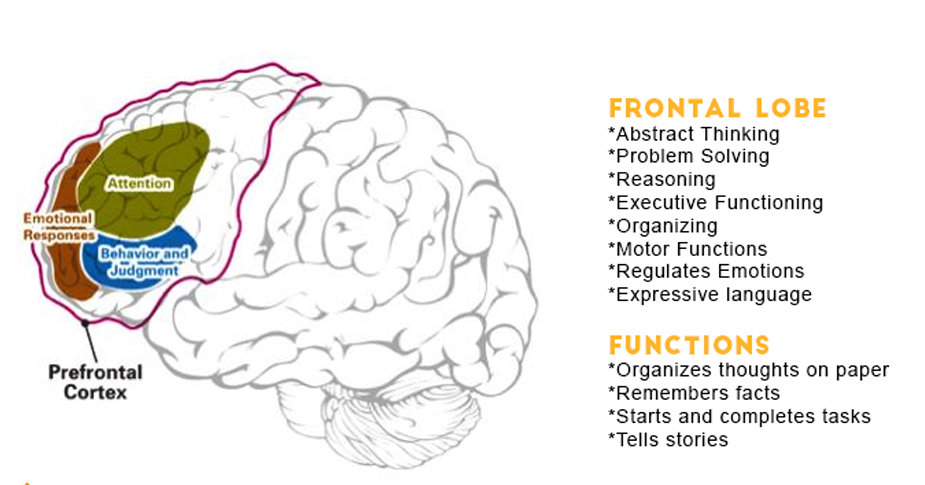
executive functions
umbrella term for goal-oriented cognitive skills and behavior
→ cognitive flexibility/shifting (ability to shift between tasks
→ inhibition (stop or suppress actions)
→ updating (ability to keep info ST and W memo)
SHIFTING:
task A: < 5 (press left) or ≥ 5 (press right)
task b: odd (press left) or even (press right)
→ slower when task is changed
as children get older improves then starts declining after middle age
INHIBITION:
A. motor inhibition → top dancing when the music stops
B. oculomotor inhibition → flanker - respond to direction of arrow in center
C. simple response inhibition → press if green do not press if red
D. cognitive inhibition → Stroop task - name the color of the word
…middle childhood: continued improvement on A B C
adolescents and adulthood: a little more improvement and D
old: decline in C but not for B and D
→ fundamental changes during preschool, refinements in speed and accuracy in school age and adolescence, different effects in aging
DO TASK SWITCHING AND INHIBITION FOLLOW THE SAME TRAJECTORIES ACROSS THE LIFESPAN?
overall no, only for response task!!!
short-term memory
passive short-term storage: retaining info up to 30 seconds without rehersal
early childhood: very limited → increases during childhood
2-3 year old → 2 digits
7 year old → 5 digits
12 year old → 6 digits (small increase)
in older age: adults retain 90% that younger adults can → much smaller age effects than working memory
working memory (WM)
active short-erm storage: keep things in mind while performing complex tasks like reasoning, comprehension, and learning
depends on the complexity of WM task
slow development: by 8 years old only half of adults
children who are better:
→ language comprehension
→ math
→ problem solving
adolescence: further brain maturation
→ info processed more quickly and in chunks
→ lower WM is associated with impulsivity and alcohol abuse
declines with age: peak either 20s or 40s
predicts performance on:
→ long-term memory
→ problem solving
→ intelligence
How does long-term memory develop?
procedural: autonomic, unconscious motor
semantic: knowledge, concepts meanings
episodic: remembering experiences
procedural memory
implicit memory develops earlier in infancy than explicit memory
changes little across life (age groups score similarly) only affected by biological decline
semantic memory
growth during childhood bc more exposure to info
preserved and even in some areas expended
→ permastore: knowledge learned long ago persists
→ BUT older adults have difficulties with tip-of-the-tongue, word finding, names
older adults struggle when info needs to be accessed rapidly, arbitrary rules → word fluency (name as many things as you can in a category)
episodic memory in childhood
development starts with hippocampus (1.5 years old)
big improvement during 2 years old
→ 6 month: remember for 24 hours
→ 20 month: remember 12 month before
3-5 years: time and location, more detailed narrative
preschool: more autobiographical characteristics
improves even more into the late childhood, advancement in strategies
strategies
mental activities (not by preschool children but older children)
encoding strategy usage increases gradually:
rehearsal (repetition): short-term memory
organization: long-term memory, includes imagery
elaboration: personally relevant, long-term memory
episodic memory in adolescents
11-12 years, young teens: similar to kids, performing worse than young adults
elaboration is mastered, important for school
selecting relative material
episodic memory in adulthood
middle adulthood: stable
older: declines
magnitude of decline depends on the task
→ retrieval condition
→ type of memories (item vs associations)
RETRIEVAL CONDITION:
performance: recognition > cued recall > free recall
→ age difference mostly in recall, not recognition
SINGLE INFO & ASSOCIATION:
age related differences: paired (associated) info (face-name)
simply recognizing faces or names (unpaired) is unaffected
→ associative deficit hypothesis
DO NOT USE LONGITUDINAL FOR MEMORY TESTS → TEST-RETEST EFFECTS!!!
How can we explain memory develop across the lifespan?
memory - mechanisms underlying change
4 HYPOTHESES ON WHY LEARRNING AND MEMORY IMPROVE AND DECLINE:
changes in basic capacities (hardware)
WM space for manipulating and processing
change sin memory strategies (software)
effective methods for storing and retrieving
knowledge of memory (metamemory)
appropriate strategies
knowledge of the world (metacognition)
to-be-learned material more familiar
BASIC CAPACITIES:
childhood:
no change in sensory register and storage capacity of long-term memory
encoding improves
hippocampus matures
speed of mental process improves → allows multi-tasking
old:
sensory abilities decline
not much change in short-term but decline in WM (prefrontal ⬇)
slower function
MEMORY STRATEGIES:
childhood:
more strategy use when personally relevant
gradual development (rehearsal, organization, elaboration)
perseveration error (<4 years): stick to old strategy
despite knowledge, no spontaneous usage
old:
many do not spontaneously use strategies
when told to do improvement, especially for higher IQ
positive effect of strategy training
KNOWLEDGE OF MEMORY:
childhood:
metacognitive awareness in a rudimentary form, improves
good metamemory → no guarantee of good recall (must also be motivated)
development continues in adolescence
old:
metacognitive knowledge maintained
can monitor memory but sometimes misjudge
negative beliefs about age memory in old age
KNOWLEDGE OF THE WORLD
childhood:
adults usually outperform on memory → reversed if children are experts
controlling of familiarity of material older children and young adults still perform better than young kids
memory improves not just because knowledge base
old:
at least or more knowledgeable than adults
knowledge not a source of memory, but help compensate for it
EXPLAIN OR NOT:
changes in basic capacities:
→ childhood: ✅❌
→ aging: ✅
changes in memory strategies:
→ childhood: ✅
→ aging:✅
knowledge of memory:
→ childhood: ✅
→ aging: ✅❌
knowledge of the world:
→ children: ✅❌
→ aging: ❌
In both childhood and aging, changes in memory strategies can explain memory change (e.g., deficient strategy use).
For both age groups, changes in basic capacities contribute to changes in memory for both ages (e.g., speed of processing).
In contrast, changes of the sensory register can contribute to memory changes in older adults but not childhood.
Metacognitive knowledge explains memory changes in childhood, but not in aging. A greater knowledge base can contribute in childhood, but not in aging –it rather compensates for information-processing losses.
CONTEXTUAL FACTORS IN AGING:
biological and environmental
→ characteristics of the learner
→ characteristics of the task or situation
→ characteristics of environment and culture
cohort effects in education and IQ, health and lifestyle
in familiar contexts high performance but not in lab
example: prospective memory (memory for intentions)
→ YA > OA in lab but YA < OA in real life
=> SOCIO-EMOTIONAL SELECTIVITY THEORY
How can we explain individual differences in adults’ cognition?
protection and resilience
risk factors: smoking, poor diet, obesity, loneliness
protective factors: engaged life, physical exercise, social support, positive beliefs, sense of control
cognitive reserve
large inter-individual variability: some 80 year olds perform better than some 40 year olds
WHY: cognitive reserve → using existing skills, attitudes and strategies to compensate => explains different susceptibility or being exposed to beneficial environments
GENETIC OR ENVIROMENTAL
CAN EITHER COUNTERACT OR SLOW DOWN AGING
SERVES AS A BUFFER FOR DECLINE
shaped by:
education
crystalized intelligence - knowledge
occupation complexity
leisure activities
SES
Baltes: lifelong
Lecture 6 - Language, Intelligence & Education/Work
How does language develop?
age 1: first steps, object permanence, joint attention (basic understanding of symbols)…FIRST WORDS!!!
nature-nurture
Skinner (NURTURE): through reinforcement for producing sounds
Chomsky (NATURE): inborn language acquisition device
NOW: social-interactionist, both nature and nurture
→ maturation of cognitive skills
→ experiences like child-centered speech by adults
crying - first communication signal
crying increases infant-parent bond
caregivers learn to read the type of cry
vital to survival → crying too little is a sign of potential neurological problem
exercise of vocal chords
from 5 months: realize that sounds have an effect on caregiver behavior
0-12 months
2 months |
|
4-6 months |
|
7-8 months | word segmentation (notice pauses between words) |
10 months | understand up to 50 words, cannot produce (comprehension before production) |
12 months |
|
18-24 months
from 1.5 years → vocabulary spurt
typical mistakes:
→ overextension: all four-legged animals are called dogs
=> assimilation
→ underextension: only own grandfather is called grandfather
=> accommodation
18 months |
|
24 months |
|
2-5 years
2-3 years vocabulary increases a lot → 1 word per 1-2 waking hour!!!
give-and-take conversations
more grammatically correct, longer sentences
function words (articles, prepositions)
typical error → overregulation: overgeneralising grammar rules = good sign
Wug test
extreme example: Genie
after severe neglect and abuse (parents did not talk to her in 10 years): started talking at age 1.5 lagging
at 13:
→ barely capable of talking
→ learned but reached a limit
→ sign language better
→ possible intellectual disability
= NATURE-NURTURE INTERACTION: you can have the capacity to learn a language(she did improve a bit when taught) but without stimulation from the environment you cannot learn a language !!!!!!!
school age
vocab continues to grow
reorganized mental vocab (dog-barks → dog-cat)
grammar: passive voice, conditional sentences
metalinguistic awareness: syntax, semantics, pragmatics (context)
reading/writing
aging
no change in knowledge of phonology (difficulty distinguishing sentences if hearing impairment)
no change in grammar or syntax, BUT less complex sentences used → with WM problems: difficulty understanding complex syntax
semantics expands
refine pragmatic use is maintained (unless major cognitive decline)
bilingualism
Baltes: gains and losses, plasticity
→ smaller vocab in each language (not exposed to same amount)
→ no delays at rate
→ by age 4 larger vocab growth
What is intelligence, how does it develop and what are influencing factors?
IQ
0-3 years | Bayley Scale of Infant Development (BSID) |
3-8 years | WPPSI: Wechsler Preschool and Primary Scale of Intelligence |
6-16 years | WISC: Wechsler Intelligence Scale for Children |
> 16 years | WAIS: Wechsler Adult Intelligence Scale |
verbal: comprehension, similarities
nonverbal: block design
normal range: 70-130
intellectual disability: <70
giftedness: >130
criticism of IQ tests
FLYNN EFFECT:
are we all getting smarter?
probably not, can be explained by:
→ education
→ improved economic conditions (nutrition, conditions, less diseases)
= COHORT EFFECTS
also not the same for all domains (revision especially for crystallized IQ)
CULTURE
integration of different theories
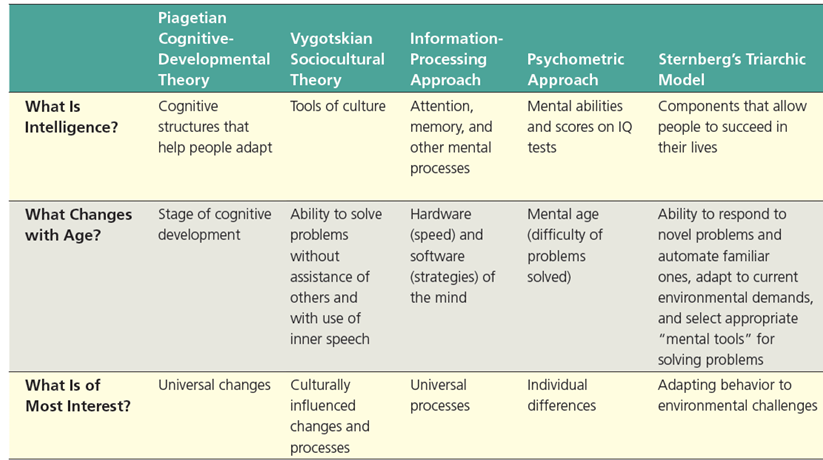
infancy
small correlation between infancy and childhood, why:
other skills are being measured
→ BSID: sensory and motor
→ WSIC: abstract skills
development influences change
→ infants: universal process
→ children: less universal influence - more interindividual differences
childhood
from age 4 IQ at different age highly correlated
earlier age predicts later age
greater stability for most
BUT instability for some (motivation, test conditions, environmental influences in life)
environmental risks for IQ
minority
unemployed or low-skilled worker parents
mother did not complete high school
absent father
stressful events
rigid child raising
anxious mother
mentally ill mother
little positive affect from mother
IQ & SES
CUMULATIVE DEFICIT HYPOTHESIS: for highest and lowest SES IQ separated by 6 points in age 2 → by age of 16 gap tripled
→ HOWEVER, brain is plastic: improvement if SES improves
IQ across lifespan
EXTREME STBILITY:
18 to 65 years → r = .87 (study 1)
11 to 90 years → r = .54 (study 2)
dual-component model for intelligence
MECHANICS: basic info processing = fluid intelligence
content-poor
universal, biological
strong genetic determination
PRAGMATICS: knowledge, factual and procedural = crystallized intelligence
content-rich
culture dependent
experience-based
intelligence across lifespan
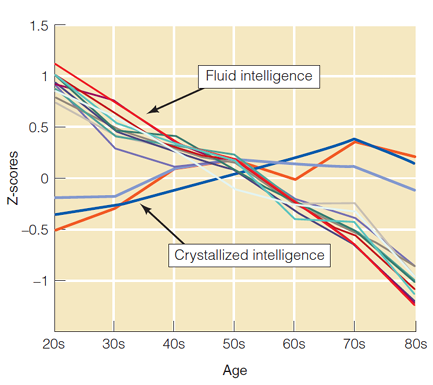
Baltes: gains and losses, multidirectional
- dissatisfaction from life
+intact marriage
What is the role of work for development? How does the work life develop?
CHANGING CAREERS:
more switches between jobs
disappearing barrier between family and work
gig (independent) work
no boundaries
adolescence | increasing number: part-time, school |
early adult |
|
middle adult |
|
late adult |
|
work transitions
Dutch participants tested 11 times:
→ NO change in self-esteem and life satisfaction related to employment
→ BUT: satisfaction with life matters!
anticipation effects: decline in self-esteem and life satisfaction before, but not after unemployment
larger effects before the transition:
psychological preparation → uncertainty outweighs reality
stressors can act already before unemployment → social pressure, finance, social status
post-transition adjustment → people partially adjust to their new situation
+ changing expectations: flexibility and control
work factors that reduce satisfaction
role ambiguity: unclear roles
role overload: too many roles
role conflict: doctors → help patients or work efficiently
work life conflict: work vs family time
unemployment
to which system of Bronfenbrenner belongs work stress of a parent?
→ EXOSYSTEM: external environment that has an indirect effect, parent’s workplace
retirement
not a single event → gradual
TRANSITION:
preretirement: info gathering, planning
honeymoon: enjoy new freedom
disenchantment: novelty wears off, aimless and sometimes unhappy
reorientation: realistic and satisfying lifestyle
Lecture 7 - Emotional Development
What are emotions and emotion regulation?
EMOTION: expression, subjective evaluation, physiological arousal
EMOTION REGULATION: central role in well-being, more complex over the lifespan
process model of emotion regulation
can be applied at different moments:
situation selection: “I wont go the exam” → avoidance
situation modification: “I’ll practice extra” → problem solving
“I’ll take someone with me to support me” → modification
attention deployment: distraction and rumination
cognitive change: “I accept my feelings” → acceptance
“It has no consequences if I fail” → reappraisal
response modulation: suppression
emotion regulation and psychopathology
MALADAPTIVE STRATEGIES:
rumination
suppression
avoidance
BUT, sometimes useful → depends on context
How do emotions and well-being develop in infants?
emotions in infants

biological basis but also environmental influences
early emotional socialization: differs from culture to culture
9 months → social referencing (visual cliff)
emotional communication: understand emotions and express them
parents plays a crucial role in emotion development → still face experiment
emotion regulation in infants
babies also regulate their emotions
0-12 months |
|
18-24 months |
|
2nd year | symbol and language capacity
|
3-4 year | prefrontal cortex development
|
How do emotions and well-being develop in children?
further improvement of emotional competence:
mixed emotions
mental time-travel → better understanding of emotions
improved ability to suppress negative emotional reactions
more complex regulation strategies:
self-initiated strategies
effective through cognition
empathy
emotional display rules: different for individualistic and collectivistic cultures → MACROSYSTEM
How do emotions and well-being develop in adolescents?
research method
experience sampling method (ESM): app, multiple times a day
diary study: only one question at the end of every day
advantages: low recall bias, ecological validity, study short-term dynamics
disadvantages: high burden on subjects, measurement reactivity
emotions during adolescence
INTENSITY (more negative):
longitudinal
daily diaries for 3 weeks
decrease in positive emotions (more decrease for girls)
increase in negative emotions (more increase for girls)
VARIABILITY (extreme swings)
explanation for changes
many positive and negative changes
ineffective regulation (executive functions not fully developed)
→ combination leads to more negative and fluctuating emotions
→ but variability becomes less after adolescence
ADOLESCENCE HAVE DIFFERENT REGULATION GOALS → COUNTER-HEDONIC (not to avoid conflict)
→ broaden horizons, acquire knowledge, meet new people, take risks
How do emotions and well-being develop in adults?
change continues
effort for emotionally satisfying, predictable, and manageable life
→ “the adaptive integration of emotional experience into satisfying daily life and successful relationships with others”
INTERSECTION OF GROWTH & DECLINE
TEMPORARY DIP IN WELL-BEING:
life transitions: raising kids, losing loved ones
social clock
How do emotions and well-being develop in older adults?
emotions in older age
better balance between positive and negative emotions: stable positive and decrease in negative emotions
explanations for change
positivity bias (negative avoidance): a form of selective attention, they control the amount of time spent on negative emotions
→ amygdala degenerates less with age than the prefrontal cortex
positivity bias
EMOTION DETECTION IN FACES: recognize fewer negative expressions
MEMORY: recall fewer negative words
socioemotional selectivity theory (SST) nurture, active, continuous, universal
emotionally meaningful goals are prioritized over exploration → positivity effect
emotion regulation in older age
STRATAGIES:
situation selection (avoidance): ↑ avoid conflict
situation modification (problem solving): ↑ but context-dependent, de-escalate conflicts more often, while younger kids seek support
attention deployment (distraction): ↑ focus on positive
cognitive change (acceptance): ↑ but no difference for reappraisal
response modulation (suppression): ↑ depends on the emotion → grief, for example
VARIABILITY:
diary studies for regulation: older adults show less variability
→ less need to adjust strategies
→ already developed effective strategies
selective narrowing of social networks
inner circle remains the same
fewer relationship with outer circle
emotional well-being goes up as networks are narrowed
10 year sequential design
empirical examination of the SST
who would you prefer to spend time with?
NO TIME LIMIT:
younger adults pick all three alternatives equally
older adults often choose close friend
TIME LIMIT:
both age groups choose close friend
→ possible to change time perspective
→ future time is crucial not age!!!
WELL-BEING DECLINES, THE YEARS BEFORE DEATH
Lecture 8 - Moral Development & Social Cognition
How does morality develop across the lifespan?
dilemma of Heinz
should Heinz break into the pharmacist’s office to steal the medicine for his wife?
Kohlberg’s moral stages
1 pre | punishment-and-obedience | heteronomous morality |
2 pre | self-interest | homo calculus |
3 | good interpersonal relationships | approval / honor |
4 | maintaining social order | law and order |
5 post | social contract and individual rights | utilitarianism + basic rights |
6 post | universal principles | Kantian THE morality QUOTE!!! |
PRECONVENTIONAL: will i be punished or rewarded?
he cannot steal bc then he will go to prison
should steal bc his wife will love him more
CONVENTIONAL: need to obey society’s rules (most 15-16 year-olds and most adults)
has to steal the drug bc that’s what a good husband does
cannot steal the drug bc then other people would also steal and the laws will breakdown
POSTCONVENTIONAL: personal moral code
cannot steal the drug bc a scientist has the right to be rewarded for his work
has to steal the drug bc the value of a life is more fundamental than property rights
theory vs data stages
theory → neatly ordered stages
data → complex
evaluation of Kohlberg
children can go beyond punishment and reward mentality
no clear transition between discrete stages → can go back and forth
stages 3 / 4 remain dominant (only 10% score higher, very few 6)
VALIDITY:
only moderate association between moral cognition and behavior → social desirability
lack of control for confounds
BUT: teenagers are famous for questioning society
alternative explanations (literature)
SOCIAL LEARNING THEORY (BANDURA)
moral behavior affected by:
observational learning
reinforcement
self-regulation
moral disengagement
situational influences
EVOLUTIONARY THEORY: we were evolved to live cooperatively in groups
How does social cognition and in particular theory of mind develop?
theory of mind (ToM)
ability to form ideas about the mental world of yourself and others and to explain behavior in terms of mental states (intentions…)
basis for:
social relationships, popularity
empathy
reciprocal conservation
humor
ability to lie
development of ToM
First social cognitive skills begins to form in infancy:
Understanding intentions
Joint attention
Pretend play: first simple pretend play between 1 and 2 years → distinguish between pretense (a kind of false belief) and reality
Imitation: in first year → ability to mentally represent others’ actions + goals
Emotional understanding: in 2nd year → understanding that other people have emotions and that these emotions can be influenced for bad or good
Desire psychology: age 2 → express what they want, explain own behavior and that of others in terms of wants or desires
ToM - social cognition of babies research - understanding intentions
6-10 months have a “moral compass” → preference for “helping” triangle compared to “annoying” square
DOES IT INDICATE DEEPER UNDERSTANDING OR JUST ASSOCIATIVE LEARNING?
SIMPLE ASSOCIATION: when reaching top = fun, that’s why baby prefers triangle (not because it understands intentions)
Indeed: square + bouncing circle → baby prefers square
BUT: triangle with goal-oriented gaze + no bounce → baby prefers triangle
→ understanding eye gaze as a sign of intentionality
ToM - joint attention
around age 1
building block for shared knowledge and shared experiences!
if it develops late or not at all: possible autism
ToM - desire psychology
BROCOLI / CRACKER EXPERIMENT
FALSE BELIEF TEST (SALLY ANNE TEST)
by age of 3-4: belief-desire psychology
→ understanding that beliefs, true or false, guide people’s behavior just as desires do
criticism:
you need more than ToM to pass
→ language, executive functions (inhibition, WM)
ToM is more than passing the false belief test
ToM - Piaget
COUNTER to Piaget, children in preoperational phase (egocentrism) can take other’s perspectives
EXPLICIT ToM: Sally-Anne
IMPLICIT ToM: where do you look at → even 15 months show this!!!
development of social cognitive abilities
age 5-7: understand people’s behavior is not the same as their thoughts
late elementary: complex second-order belief statements
schoolchildren → sarcasm
middle and late child: beliefs ca be false, multiple interpretations
social cognitive skills continues to improve after adolescence
better maintained in adulthood than nonsocial cognitive skills
older age → social cognitive skills improve further
YET: some decline → sarcasm, failing adult versions of ToM tests
How does empathy and prosocial behavior develop?
AFFECTIVE EMPATHY: emotional connection
COGNITIVE EMPATHY: rational understanding, other’s perpective, ToM
empathy - newborns
newborn: emotional contagion
age 1: early tendency to imitate emotional expressions
affective empathy
no distinction between own emotions and other’s
development of empathy
from age 1, empathic concern
→ for this distinction between self and other is needed SELF-AWARENESS
development of empathy between 1-2 year-old
development of prosocial behavior in childhood
INSTRUMENTAL HELPING (12-14 months): helping with a goal-directed action (picking up an object out of reach of the other person)
EMPATHIC HELPING (18-24 months): comforting
→ girls more, bc more rewarded?
children struggle with helping if: only subtle cues and emotional state (rather than instrumental helping)
prosocial behavior → concrete operational
product of ToM
middle childhood: requires info processing
school children also help effectively
How does antisocial behavior develop?
aggression → motor and cognitive development
reactive: impulsive response to frustration
proactive: instrumental, intention to reach a goal
direct: calling names to someone’s FACE (peek 2.5, decline in middle childhood)
indirect (relational): behind someone’s back (peeks during adolescence)
aggressive behavior - gender differences
boys more physical aggression, but both boys and girls same amount of relational aggression
consequences bigger for girls
juvenile delinquency - explanations
FAMILY & ENVIRONMENT:
strict/inconsistent parenting
alternating or single parents
NEUROCOGNITIVE & DEVELOPMENTAL:
early neurological impairments
low motor skills and IQ
reading and memory problems
BEHAVIORAL & SOCIAL FACTORS:
hyperactivity and self control problems
rejection by peers
interaction with delinquent peers → ONLY LATE-ONSET RISK FACTOR
ADDITIONAL:
behavioral difficulties in early childhood
family conflicts
young age mother
BUT THEY HAVE NOT LOST THEIR ToM OR EMATHY
antisocial and risk behavior - Moffitt’s theory
2 types of antisocial behavior
EARLY-ONSET (PERSISTENT):
only 5% of male pop.
often neurocognitive deficits (gene-env int.)
recidivism
difficult families and neighborhoods
problems start early and are exacerbated by a high-risk environment
LATE-ONSET:
majority of adolescents (normal)
imitate early-onset
SAME BEHAVIOR, DIFFERENT MOTIVATIONS
antisocial and risk behavior - explanations
BRAIN DEVELOPMENT:
increase in neurotransmitters, particularly dopamine
→ risk taking
→ reward seeking
limbic system almost developed in early adolescence, BUT prefrontal cortex not finished until 18-25 years
→ GAINS AND LOSSES
AGE - MATURITY GAP:
cognitive and physical maturation
budding motivations (sexual, autonomy, status)
social limitations
ADDITIONAL:
not seen in every adolescent
not necessarily an error in calculation but functional
→ individuation: distancing from parents
→ experimenting
→ bonding with peers
Lecture 9 - Social Development 1 (Infancy - Adolescence)
What is attachment and how does it develop in infants?
attachment: nature
biologically programmed response
but also stimulus from environment (boots)
attachment: nurture
behaviorists → attachment is caused by association with food (reinforcement) WRONG - HARLOW
ADVICE: keep emotional distance
Bowlby: attachment theory
“Maternal love in childhood is as important for mental health as vitamins and protein are for physical health”
NATURE - NURTURE INTERACTION
NATURE:
inborn tendency to attach
critical period
BUT: proximity-seeking behavior when threatened AT ANY AGE
NURTURE:
caretaker’s influence on development
undiscriminating (0-3 months) | no obvious attachment, but smiles back |
discriminating (4-6 months) | slight preference for primary caregiver (developing cortex) |
active proximity seeking or true attachment (7-8 months to 3 years) |
|
goal-corrected partnership (3 years +) | adjust behavior to parent’s goals |
critical period: when baby starts moving
safe haven, secure base
evolution: attachment is good for survival
attachment styles
avoidant: no separation anxiety and little emotion when parent returns
resistant/ambivalent: much anxiety, inconsolable when parent returns
disorganized/disoriented: not consistent, frozen or running away
affects internal working models
→ cognitive representations of self and others
→ social info
CRITICISM OF ATTACHMENT STYLES / STRANGE SITUATION:
categories overly simplified
disorganized → mixed group
20 min not sufficient
cultural differences may impact results
research shows: children with difficult temperaments are more susceptible to the influence of sensitive parents
= GENE-ENVIRONMENT INTERACTION
infant attachment universal?
yes and multiple relationships possible
BUT some cultural differences
→ Japan: more likely to be distressed (uncommon to separate)
→ Germany: avoidant (independent fostering)
early deprivation and daycare
EARLY DEPRIVATION:
secure attachment still possible, but timing and severity crucial!!!
→ Romanian orphanages (early adoption 60% secure, late adoption 30% secure)
DAYCARE:
depends on the quality
What is the purpose of play behavior in children?
types of play
solitary play: alone, makes a drawing
parallel play: only next to each other, both make their own drawings
associative play: side by side, make own drawing, no shared goal but exchange pencils, follow each other’s example, comment
cooperative play: work together on a drawing
development of play
MORE SOCIAL
MORE IMAGINATIVE:
start of pretending → later infancy
collaborative pretend play → age 4
AFTER AGE 5, SERIOUS PLAY (LESS PRETEND)
How do social relationships develop in childhood?
popularity
elementary school
social status → primary goal
concrete operational → sensitive to social comparison
sociometric status (peer nominations)
CONTINUOUS OUTCOME MEASURE:
social preference score = acceptance - rejection
CATEGORICAL OUTCOME MEASURE:
popular (high +, low -) - 11%
rejected (low +, high -) - 13%
neglected (low +, low -) - 9%
controversial (high +, high -) - 7%
average - 60%
social exclusion and peer rejection
different reasons (but same consequences):
INTERPERSONAL: individual differences (attractiveness, social deficits, temperament
INERGROUP: bias or prejudice regarding cultural groups
bullying
not limited to childhood, also in adulthood
starts early
main motivation: gaining status
LONG-TERM CONSEQUENCES: INFLAMMATION MARKERS (CRP)
→ experienced bullying increases CRP levels
interventions
SOCIAL SKILL TRAINING:
mixed or no results for half of the studies
not efficient for bullying based on group membership
ANTIBULLYING PROGRAMS:
→ OLWEUS BULLYING PREVENTION PROGRAM: focuses on school as a whole, the class, the individual, and the broader community = SUCCESFUL
/
BOYS ARE MORE LIKELY TO HANG OUT WITH BOYS
How do social relationships develop in adolescence?
changes in social life
PARENTS TO PEERS:
change of internal working models for attachments to parents and friends/partner
FRIENDSHIPS:
middle school: unisex cliques
late middle school / early high school: crowds
high school: mixed-sex cliques
emerging adulthood: romantic partners
ROMANTIC RELATIONSHIPS:
three stages:
entry into romantic attractions (11-13)
puberty
crush, sometimes same crush as a friend, if dating then in a group setting
exploring romantic relationships (14-16)
both casual and group dating
consolidating dyadic romantic bonds (17-19)
more serious, emotional
peer influence
studies:
questionnaire
resistance to peer influence scale
result (3 large samples): influence decreases linearly between age 14 and 18
experiment
driving task, alone or with peer
adolescents make riskier decisions under peer influence, then by young adults decline
Attachment and autism
children with ASD significantly less securely attached
→ effect moderated by mental development: less severe ASD group and control group did not differ
BUT they can form secure attachments, security of attachment doe not differ from typical children
insecure attachments more likely:
ASD + intellectual disability/ development delay
more severe
poor parent-child interaction
few responses to caregivers (hard to understand the kid)
neurobiological studies: children with ASD also show increases in cortisol during stress and oxytocin during interactions with caregivers
→ despite lower hormonal baseline, they experience similar hormonal changes during separation and reunion
Lecture 10 - Social Development 2 (Adulthood)
Long-term romantic relationships
❤ similarity → homogamy
❤ complementarity → filling gaps
❤ personality traits like NE and A
similar values, beliefs, personality traits
similar background → basis
similar personality
Stenberg’s triangle
passion → intimacy → commitment
keeping passion and intimacy takes work
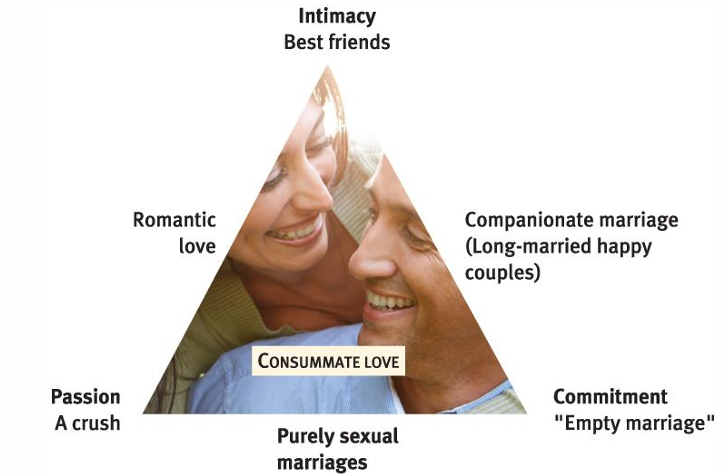
Marriage, relationship satisfaction and divorce
attachment in adulthood
you partner | + | — |
+ | SECURE low anxiety, low avoidance | PREOCCUPIED resistant/ambivalent high anxiety, low avoidance |
— | DISMISSING avoidant low anxiety, high avoidance | FEARFUL disorganized-disoriented high anxiety, high avoidance |
dismissing: fear of intimacy, shut down, inhibit feelings
preoccupied: obsessive and jealous, emotional during conflicts
→ internal working models are shaped by parent-child relationship, but can be changed by sensitive partners
does marriage make people happy?
marriage status in indeed linked to better health and subjective well-being (greater for men)
BUT only for happy marriages!!!
no difference in midlife happiness in married vs long-term cohabiting
honeymoon phase
decline
slower decline
stable around year 4
positive change → empty nest
→ yet, most are far more satisfied than dissatisfied → still happy but more realistic
DIVORCE COMMON AFTER 7 YEARS
Diverse lifestyles in midlife
marriage no longer a fixed “institution”
deinstitutionalization: decline in marriage and emergence of alternative family forms
childbirth without marriage
divorce
children living with one parent
living alone
→ HISTORICAL-EMBEDDEDNES
not marrying becoming normal
more normal to live together for some time before getting married or to continue as unmarried couples
→ more 35 year old cohabit, BECAUSE “MARRIAGE DOES NOT ADD ANYTHING”
gay marriage
NL 2001 → US all states 2015 → GR 2017
very similar to hetero marriage
balance
children
more flexible gender roles
higher average relationship quality
single (cohabiting and dating included)
stereotypes: swinging single vs desperately lonely, suicidal
indeed: diversity of reasons (chosen, not chosen)
deep bonds with siblings, friends, younger adults
advantages and disadvantages
olde adults who never married can cope better with loneliness
US survey: uncertain 39%, wants to 34%, does not want to 27%
Parenthood
challenges for new parents
neurobiology
self-concept, identity
perceived efficacy
emotional health
…
mental health of new parents
17% → postpartum depression (large global differences)
risk factors:
education
income
stress
complications at birth
social support/network
perinatal mental health
planned pregnancy
violence
division of labor
MOST WOMEN WORK PART-TIME
fathers are stepping up, but some gender roles remain:
fathers play more than childcare
wins and losses
major transition with both growth and loss
SOC model: parents use compensatory processes to minimize losses
example: less sleep time is compensated with reprioritizing (going to bed early) or combining activities
parenthood and the brain
decrease in cognitive functions and rain volume in pregnancy (persisting for at least 2 years)
change in brain volume were positively related to maternal attachment after delivery
→ adaptive specialization: brain functions related to mother-child bonding are prioritized
after childbirth
initial positive effect on only life satisfaction (LS)
LS and relationship satisfaction (RS) decrease
RS permanently below pre-birth level
effects on affective well-being (AWB) are small but positive
transition to parenthood
RELATIONSHIP SATISFACTION:
relationship satisfaction increases before birth (honeymoon effect) decreases after birth
decreases even further after the second child
SELF- ESTEEM:
decrease related to birth
no major differences between first and second child
positive effects on parenthood??!??!?!
HOWEVER 3 STUDIES SHOW POSITIVE EFFECTS FOR PARENTHOOD → WHY?!
= social desirability and selectivity of sample
grandparenthood
first time grandparent mostly during middle age
increase in longevity → live longer
different meanings: biological reward and continuity, emotional self-fulfillment, or remote role
gender differences: grandmothers have more contact
cultural differences: Mexican Americans have more more contact than non-Latino and African Americans
empty nest?
empty nest syndrome → not majority, but decline in marital satisfaction
BUT for most increase in marital satisfaction
BOOMERANG KIDS:
can be a positive experience for both but also…
for parents: loss of privacy, conflicting schedules, partner relationship invaded
for children: loss of privacy and independence
changing profile
increase in children that live with grandparents (divorce, adolescent pregnancies, drug use of parent)
full-time caregiver grandparents: elevated risk for health, depression and stress
→ they are often low-income minority groups, and not married
Lecture 11 - Family
What are different parenting styles?
parenting styes (Baumrind)
control | high warmth/support | low warmth/support |
high | ❤ authoritative ❤ | authoritarian |
low | permissive | neglecting |
criticism on parenting styles
parenting is LESS STATIC and MORE BIDIRECTIONAL and child-evoked (parents relationship influences each parents relationship with child vice versa)
INDIVIDUAL DIFFERENCES:
longitudinal study (biweekly questionnaires)
→ effect of parenting styles can differ between children
→ link between support and depressive symptoms
21% adolescents: parental support = fewer depressive symptoms (in line with Baumrind)
51% adolescents: no effect
27% adolescents: parental support = more depressive symptoms → supportive behavior can backfire (parental over-involvement)
CULTURAL DIFFERENCES:
Baumrind = western
individualistic → autonomy, self-reliance/-interest (authoritative)
BUT collectivist → interdependence (authoritarian)
Turkish mothers were less supportive and less authoritative and more intrusive in their control
factors influencing parenting styles
genes
how parents were raised
SES and education
environment (dangerous → authoritarian)
culture
helicopter parents
positive effect in parent reports, but negative effect in adolescence reports
well-intentioned
positive effect for fathers, negative effects for mothers
→ fathers are often less involved: overprotective behavior as a sign of care and concern
What do we know about the effects of diverse family experiences?
siblings
firstborns can become more demanding, dependent and clingier, also develop problems with sleeping, eating, and toilet routines, even secure attachments can become insecure
BUT most firstborns adapt well
sibling rivalry: normal part of sibling relationships
→ siblings fight less if parents fight less and treat children equally
→ difference in treatment is acceptable if depends on age
→ relationship characterized by both closeness and conflict
PSYCHOPATHOLOGY:
more sibling warmth, less conflict, less different treatment = less internalizing and externalizing problems
→ largest effect: sibling conflict
→ gender combination: more for brother-brother
→ age difference: more for small age difference
→ development period: more for children than adolescents
divorce
NL STATISTICS:
decrease in total divorce, but its bc lower marriage numbers
50% divorce
large proportion involve children
SHOULD PARENTS STAY TOGETHER FOR KIDS?
difficult to determine
reconstituted families
3 common types:
stepfather
stepmother
blended/complex
with time children adjust to SIMPLE stepfamilies
function better than children in conflictual non-divorced families and complex
> 75% positive relationship with stepparent in simple step families
family structure not critical but good parenting
What do we know about the effects of child maltreatment?
statistics
119.00 children per year in NL
1 child per classroom
depends on who you ask (self vs informant reports
grey zone issue
SEXUAL ABUSE:
world-wide meta-analysis:
girls: 9% forced intercourse and 15% mixed sexual abuse
boys: 3% forced intercourse and 8% mixed sexual abuse
> 90% know the perv
most often to children between 8 and 12 year
prevalence varies
→ might be higher for men than reported
→ South-Africa high percentage
potential consequences
emotion dysregulation
lower social competence
personality pathology
internalizing problems (anxiety, depression)
externalizing problems (aggression, substance abuse)
sexual problems or sexual risk taking
suicide
increased risk for diabetes, lung disease, malnutrition, and vision problems
structural brain changes (small prefrontal cortex)
→ timing matters bc brain areas develop at different times
How can resilience help to deal with challenges in childhood?
resilience - different theoretical models
CHALLENGE MODEL: moderate adversity leads to better adaptation than no or extreme adversity
DEPLETION MODEL: adaptive function stable until adaptive capacity is depleted, after which it declines sharply
COMPENSATION FACTOR: protective gene enhances adaptation regardless of the risk severity → MAIN EFFECT
PROTECTION FACTOR: positive gene protects especially when severe risk → MAIN EFFECT + INTERACTION EFFECT
VULNERABILITY FACTOR: negative gene increases vulnerability at high risk → DIATHESIS-STRESS MODEL
CONTEXT-SENSITIVE FACTOR: negative gene is beneficial at low risk but detrimental at high risk → DIFFERENTIAL AT HIGH RISK
resilience - adaptive processes
POSTTRAUMATIC GROW: function more after trauma
STRESS-RESISTENCE: stable functionality
BREAKDOWN AND RECOVERY: low function after trauma but then go back to normal
resilience - core characteristics in environment
parenting matters more than genes
peers matter:
→ HARRIS: socialization to become adults is facilitated by peers not parents (collective efficacy matters)
→ BRONFENBRENNER: many influences
resilience - longitudinal study
people with a history of some adversity have better mental health than people who had no adversity AND severe adversity
→ in a small dose “what does not kill me makes me stronger”
→ but depends on the adversity (severity, timing)
resilience in children of parents with depression
20% resilient
protective factors:
→ support from co-parent
→ good social relationships
→ self-confidence
→ frequent physical activity
Lecture 12 - Personality & Identity Development
How do temperament and personality develop?
temperament
inborn behaviors to deal with the world
NY - LONGITUDINAL STUDY:
EASY: 40%
SLOW TO WARM UP: 15%
DIFFICULT: 10%
ROTHBART:
temperament = infant reactivity + capacity to self regulate
→ SURGENCY/EXTRAVERSION
→ NEGATIVE AFFECTIVITY
→ EFFORTFUL CONTROL: focus and shift attention, inhibit responses, low-intensity activities (self-control at age 3)
surgency/extraversion and negative affectivity visible from infancy on
effortful control → toddlerhood/early childhood
HOW TO MEASURE IT?
EXUBERANCE: puppets → measure laughter/reservation
FEAR-ELLICITING CONDITION: frightening toys
ANGER-ELLICITING CONDITION: restrain child in a car seat → measure frustration
temperament as a risk factor
SHY: 1 in 5
early signs of conscience, no discipline problems (+)
can persist into adulthood (-)
later developement:
focus on threatening stimuli
internalizing problems
fear and inhibition usually decrease with age
→ refrain from overprotection
EXUBERANT: happy, disinhibited, fearless in new situations and new people
no use of “power assertion” (screaming, hitting)
sensitive and positive parenting
calm reasoning when whining
time-outs for defiant behavior (?)
GOODNESS OF FIT / PERSON-ENVIRONMENT FIT:
parenting style and environment is adapted to temperament
shy → calm environment
exuberant → opportunity to explore and run
temperament development
infant temperament = childhood
infant temperament \neq adult (big five)
but individual differences (due to environment)!
EARLY CHILDHOOD:
difficult behavior:
shift
angry
cannot wait
easily upset
won’t share…
→ AURONOMY vs MISTRUST (1-3 years)
learns to do more himself
testing/crossing boundries
“terrible 2”
emotional development:
year 1: primary emotions
year 2: more complex, pride and shame → self-awareness
conscience development improves from 2 to 4
socialization → less unwanted behavior
self-regulation:
individual differences!!!
differences in self-control have GENETIC ROOTS (TEMPERAMENT)
cleaning more difficult than not laying with toys
girls and fearful inhibited children more obedient
stability over time (1 → 4)
MARSHMALLOW TEST
children who waited had better school performance and body mass
→ SES, not willpower
developing personality
roots of adult personality in childhood, but full personality formation takes many years !!!
continuity and discontinuity in personality - adulthood
CONSISTENCY IN RANKINGS:
high correlation
correlation increases with age (not much change after 50)
MATURITY PRINCIPLE:
more emotionally stable (neuroticism -)
more cooperative ad easy to get along (agreeableness +)
more responsible (conscientiousness +)
adolescence to middle adulthood → starting work
little systematic changes after that, only because experiences
personality adjustment across the lifespan
NE and C → health
N and A → coping
How do self concept and identity develop?
self concept - infancy
→ born without self-concept
→ develop implicit sense of self ( based on own body, interaction and actions)
capacity to differentiate (sense of agency) → 2 - 3 months
end of age 1: companions as separate beings → joint attention
18 months: self-recognition
18-24 months: awareness of who they are → self-referring language
SELF-RECOGNITION:
ROUGE (mirror) TEST
around 18 months pass
also depends on experience with reflecting surfaces
self-concept - childhood
associated with emotions
preschool: physical
by age 8: psychological (nice or bad)
→ enduring qualities (funny, sporty)
→ part of social groups
→ social comparison
self-concept - adolescence
more psychological
more abstract
more differentiated (different “selves” in different social contexts)
more integrated and coherent (inconsistent)
more reflection (self-conscious)
identity - emerging adulthood
identity information
classification on four identity status based on progress toward identity in each several domains
crisis
commitment achieved
→ IDENTITY vs ROLE CONFUSION - FIDELITY
DIFFUSION: no crisis, no commitment
FORECLOSURE: no crisis, commitment made
MORATOURIUM: crisis experienced, no commitment
IDENTITY ACHIEVEMENT: crisis experienced, commitment made
identity achievement associated with:
psychological well-being
self-esteem
complex thinking about moral and social issues
willingness to accept others
mental health
factors influencing identity formation
cognitive development: formal-operational
personality: low N and high C, O
relationship with parent:
neglected → diffusion
extremely close → foreclosure
opportunities for exploration: attending uni
cultural and historical context: homosexual, western vs traditional societies
current misconceptions of midlife
most common myth: MID LIFE CRISIS
based on:
dreams that have not yet been fulfilled
pressure to change life as long as there is time
MID LIFE CRISIS → MID LIFE QUESTIONING
strong conceptualization: different from other transitions (emotional wearing)
moderate conceptualization: normative, wearing transition, NOT different from other transitions
= no winners !!!
→ tied to events and neuroticism
EXPALNATIONS:
first experience of aging
evaluation of life
social norms
well-being lowest point
cultural influence (youth-oriented vs wise-elderly)
→ SOCIAL COCK & SOCIO-EMOTIONAL SELECTIVITY
identity in older age
positive self-image achieved by:
reducing gap between ideal and real self
changing one’s goals and standards of self-evaluation
making social comparisons to other old people (and not young people) → downward social comparison
avoiding negative self-stereotyping
How does self-esteem develop?
self-esteem
preschool children only distinguish 2 broad aspects:
→ competence (physical and cognitive)
→ personal and social adequacy (social acceptance)
Harter: self-esteem based on social comparison → age 7
children who lean toward…
INTERNALISING PROBLEMS:
low self-esteem, read failure in everything
learned helplessness
failing due to lack of trying (as they think they will fail)
EXTERNALISING PROBLEMS:
unrealistically high self-esteem, when fail blame others
failing due to lack o self-insight / ignore real problems
PARENT ADVICE:
little encouragement and compliments → low self-esteem
too much or 2empty2 compliments → unrealistically high self-esteem
complimenting hard work, or success → realistic self-esteem
encourage accurate perceptions:
→ internalizing: the class does not hate you
→ externalizing: kids won’t like it if you barge in
self-esteem - development
accuracy of self-evaluations increases across elementary school
young children → inflated views of themselves
age 8: more realistic
girls and boys enter first grade with same level
gender differences emerge by early adolescence
→ see book for trajectories
self-esteem - gender differences
across all nations:
main effect of age ↑
main effect of gender //
no interaction between age and gender
→ more differential picture when comparing nations
self-esteem - cultural differences
gender gap: North America > South and Central America > East Asia
South America: gender gap increased with age (age effects stronger for males
= BRONFENBRENNER & SKINNER’S LEARNING THEORY
HOW CAN WE EXPLAIN THESE DIFFERENCES:
SOCIOECONOMIC:
GDP per capita
HDI
distribution of income
SOCIODEMGRAPHIC:
mean age of marriage
adolescent fertility
GENDER-EQUALITY: interaction effects
gender gap
number of years that women have right to vote
CULTURAL VALUE:
acceptance + expectation of unequal distribution
individualism vs collectivism
masculinity vs femininity → age effects
uncertainty avoidance → gender effects